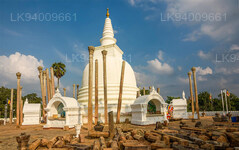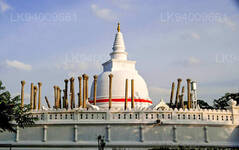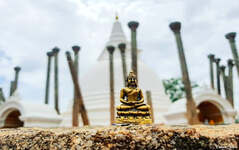
Città di Anuradhapura
Anuradhapura appartiene alla Provincia Centro-Settentrionale dello Sri Lanka. Anuradhapura è una delle antiche capitali dello Sri Lanka, famosa per le sue rovine ben conservate dell'antica civiltà lankese. La città, oggi Patrimonio dell'Umanità UNESCO, si trova 205 km a nord dell'attuale capitale Colombo, in Sri Lanka.
Thuparamaya (ථූපාරාමය)
Thuparamaya, the oldest Stupa in Sri Lanka built after the introduction of Buddhism to Sri Lanka. The Thuparamaya, built by King Devanapiyatissa, enshrines the sacred collar bone of the Buddha. This relic, a gift from India, stands testimony to the cordial relations enjoyed by the then Sri Lanka ruler. The columns around the stupa were a part of the walkway that supported a roof which covered the sacred edifice. Aesthetically, the interior of such a structure must have been the stunning expression of wood engineering and of the most skilful craftsmanship. The edifice’s conical design, unique in the architectural history of the world, continues to be discussed and debated by scholars and scientists. The discovery of medical texts and surgical instruments dating back to the Anuradhapura period confirm the Quality of life during that era. The tradition of using stone troughs as medicinal baths to cure the sick was in vogue during the Anuradhapura and subsequent Polonnaruwa periods and before Buddhism was introduced to Sri Lanka. The patient, whether paralytic or in a coma after a snake bite, was immersed in a bath enriched with the appropriate medicinal potions that would gradually be absorbed into the body. Interestingly, the shape of the vessel was moulded to economize on the expensive fluid. The name Thuparamaya is a residential complex for Bhikkhus.
Informazioni sul distretto di Anuradhapura
Anuradhapura appartiene alla Provincia Centro-Settentrionale dello Sri Lanka. Anuradhapura è una delle antiche capitali dello Sri Lanka, famosa per le sue rovine ben conservate dell'antica civiltà cingalese. La città, ora Patrimonio dell'Umanità UNESCO, si trova 205 km a nord dell'attuale capitale Colombo, in Sri Lanka. Nella città sacra di Anuradhapura e nelle sue vicinanze si trovano numerose rovine. Le rovine consistono in tre classi di edifici: dagoba, edifici monastici e pokuna (stagni). La città possedeva alcuni dei sistemi di irrigazione più complessi del mondo antico; situata nella zona arida del paese, l'amministrazione costruì numerose cisterne per irrigare i terreni. La maggior parte dei civili è cingalese, mentre nel distretto vivono anche tamil e mori dello Sri Lanka.
Informazioni sulla provincia centro-settentrionale
La Provincia Centro-Settentrionale, la più grande del paese, copre il 16% della superficie totale del paese. La Provincia Centro-Settentrionale è composta da due distretti chiamati Polonnaruwa e Anuradhapure. Anuradhapura è il distretto più grande dello Sri Lanka. La sua superficie è di 7.128 km². La Provincia Centro-Settentrionale ha numerose potenzialità per gli investitori che desiderano avviare le proprie attività, in particolare nei settori dell'agricoltura, dell'industria agroalimentare e dell'allevamento. Oltre il 65% della popolazione della Provincia Centro-Settentrionale dipende dall'agricoltura di base e dall'industria agroalimentare. La Provincia Centro-Settentrionale è anche chiamata "Wew Bendi Rajje" perché nella provincia si trovano più di 3.000 serbatoi di medie e grandi dimensioni. Sri Maha Bodiya, Ruwanweli Seya, Thuparama Dageba, il monastero di Abayagiri, Polonnaruwa Rankot Wehera e Lankathilake sono luoghi di interesse.














